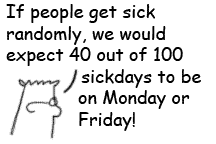Computer = brute force
If you have clicked the button a few times, you've seen that the results vary quite a bit. Here are the first ten results that I got:
| Trial #: | 1 | 2 | 3 | 4 | 5 | 6 | 7 | 8 | 9 | 10 |
| Mondays/Fridays | 43 | 33 | 37 | 47 | 40 | 37 | 39 | 41 | 41 | 51 |
What have we accomplished so far? First, we made a hypothesis about what causes sickdays -- namely, they happen on randomly chosen days. The competing hypothesis, held by the pointy-haired boss, is that sickdays occur disproportionately on Mondays and Fridays.
| First step: pick a hypothesis | |
 |
 |
Secondly, we calculated how many sickdays "should" fall on Mondays or Fridays according to our hypothesis -- that is, 40%, or 40 out of 100. This is the expected value of sickdays. But since we're dealing with a random process, we also expect some scatter around that expected value. The key question is, how much scatter?
| Second step: calculate the expected result | |
 |
 |
Next we used a simulation of randomly chosen weekdays to investigate how much scatter to expect around the 40 out of 100 prediction.
| Third step: simulate the scatter | |
 |
 |
In the 10 trials, listed above, how common was it to get 42 or more Monday/Friday sickdays?
(To make this problem interactive, turn on javascript!)
- I need a hint ... : Try counting how many trials had at least 42 Mon/Fri sickdays
- ...another hint ... : 3 out of 10 trials had at least 42 Mon/Fri sickdays -- what percentage is that?
I think I have the answer: 3 out of 10 trials had at least 42 Mon/Fri sickdays,
or 30%, which seems pretty common.
Time for a donut break!
Copyright University of Maryland, 2007
You may link to this site for educational purposes.
Please do not copy without permission
requests/questions/feedback email: mathbench@umd.edu